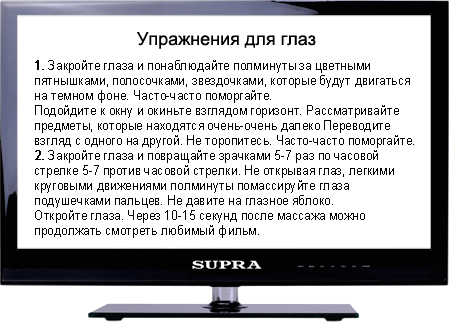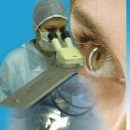New Year's Eve - Gift Time for Gifts, Guest Invitations and Planning Night. How to do without a TV? «Blue screen» - Excellent gift for loved all holiday and faithful companion of New Year's celebration. But how to choose a decent, and most importantly safe for health TV? Let us leave a description of the functionality and praising the parameters of the TV manufacturers and try to approach the question from a medical point of view.
Content
The first mass tv in our country looked impressive. Wooden box of impressive sizes with small, 3 on 4 centimeters, screen. To see something, mounted on it or set a plane-spherical vessel filled with liquid (water, glycerin or even Castor). Vessel worked like lens, increasing black and white image. Add to this more ripples and flickering screen and get after 15 minutes of viewing such a TV fatigue and stress in the eyes.
Modern TV — Raisin Interior — Stylish panel, thickness of only a few centimeters, with a color flawless image on the big screen, with a bunch of various settings and functions. But whether the TV XXI century is safe? Especially for our eyes?
From CRT to LED
At the beginning of the era of televisions as a source of image (black and white), an electronic radial tube (CRT) was used in the TVs. Inside it, electrical signals were transformed into light, due to which the image was formed on a kinescope.
Then there was a color. The picture has become a clearer, but in brightness could be heterogeneous (more pale to the periphery of the frame). Often, color points could be seen on the screen — flaw in the work of CRT. They were tired of their eyes, attention was scattered.
The next significant step in the evolution of the TV, and, accordingly, in increasing its level of safety, it became literally parallel to the appearance of liquid crystal (LCD, or English. LCD — Liquid Crystal Display) and «Plasma» Models. The source of formation of the image in them was the matrix: based on liquid crystals, highlighted by fluorescent lamps, and on the basis of self-losing cells with an inert gas, respectively. It gave a picture of high definition and with good color reproduction. And the lack of CRT immediately reduced all questions about emissions on «No».
And just recently, the manufacturers have entered the market with a novelty — LED TV. LED is an advanced LCD in which fluorescent lamps have been replaced with light emitting diodes (Light Emitting DIODE). It even more increased the contrast of the picture and made it more reliable. In addition, the LED illumination increased the performance of the matrix (response time to the filed signal), which practically eliminated distortion from rapid changes.
What to pay attention to the selection of LED-TV
It turns out that the LED TV has practically no harmful effect on our vision. However, the Buyer should pay close attention to a number of parameters. Otherwise, problems can be released with safety and harmlessness.
So, if you decide to buy a modern LED TV, you need to start with the definition of the optimal screen size (length diagonal in inches) for your conditions. Doctors recommend watching TV from a distance that will be at least five of his diagonals. For example, from your chair to the television panel 4 meters. 4/5 = 0.8 meters or 80 cm — Diagonal length. To translate this figure in inches (1 inch = approximately 2.5 cm), 80 cm divide by 2.5. So, then your choice will take place among models with a diagonal in the area of 32 inches. They estimated the sizes of their room, counted?
Now let's deal with the screen resolution. Permission — This is the number of LEDs (pixels) per unit area. Than them are more, the picture is more than darkened. Those let's say it's easier to watch it. However, along with the number of pixels, the price is growing. But there is no point in buying an expensive model with a very high screen resolution. Without additional expensive equipment, you can not enjoy. Therefore, focus on 1024×728, 1280×720 or 1388×768.
Contrast — White brightness ratio to black brightness that can reflect the TV screen. The higher the better for the eyes. Must be at least 800: 1 (for example, Samsung, Supra).
Definition — TV ability to play minor and average image details with maximum contrast. The higher the better for the eyes. Depends on screen resolution.
Brightness — The amount of color in the image, its saturation. The higher the better. Sufficient value — 300 cd / m2
Corner view — How much can you deviate from the center of the screen left or right and see the picture almost unchanged. Norm — at least 170 degrees (for example, SUPRA, Philips, Sony).
Here are some simple ways to determine the safety of a health TV. And yet, when you choose, look first of all to «Japanese». Still electronics — These are their Konk.
It's all up to us
Despite the fact that the most modern TVs have a uniform backlight of the matrix, which increases the contrast of the picture and therefore practically does not load the eyes, let's listen to the advice of the ophthalmologist Swarina.
«Any monotonous activity tires. Whether it is a bike riding, shelling beds or watching favorite TV shows. So try to break away every hour from the TV at least 5 minutes. During this time, you will have time to make several exercises for the relaxation of the eye muscles and remove the tension from them. Exercises do in order of increasing load. And while watching TV, observe the elementary eye hygiene rules».
TV viewing rules
- Observe the distance to the screen (at least five diagonals).
- Do not watch TV in complete darkness. Turn on any light source.
- The TV screen should not be glared. It should not reflect the lamp, windows, other bright items.
- Do not look at the TV at an angle, even if it allows the screen.
- Take the rule every hour to take a break and perform at least two exercises.










